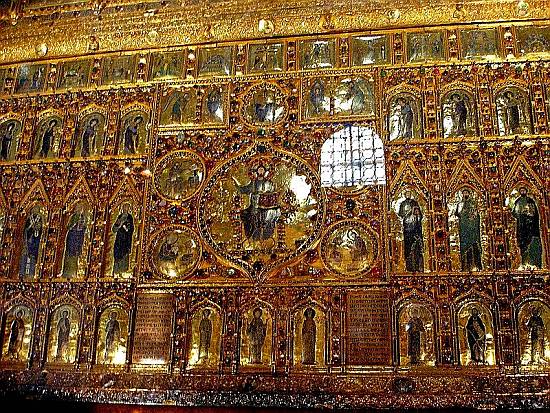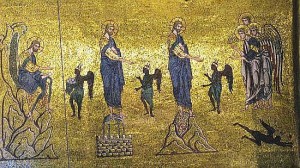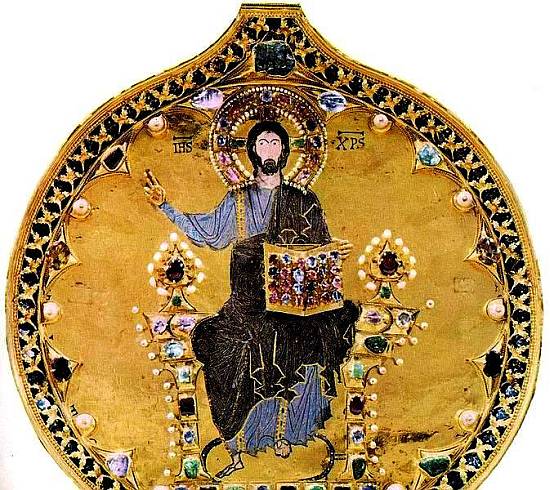
I can tell you precisely when was the last time I sat and looked at art. It was Easter morning, and I wasn’t in a museum.
We were sitting in the front row of the basilica of San Marco and the occasion was the elaborate festal mass. The sermon was well underway. I had had every intention of listening carefully, because it was the new patriarch’s maiden voyage and I had been curious to check his rigging and navigation skills on one of the biggest days of the year.
If you’d like to know more, you’ll need to ask someone else. Because while he didn’t drift into uncharted political or theological waters (I’m finished with this metaphor now), as his predecessor used to do, he wanted to convey a message I couldn’t follow, and he was in no hurry to finish it. It was the religious equivalent of the stationary bicycle.
To be fair, he could just as well have been reading the Government Printing Office Style Manual, because the basilica of San Marco is an Olympics-level competitor if you’re trying to get somebody’s attention. So I made the most of being installed in my seat for a while, and let my eyes wander around the opulence of the basilica itself. And where my eyes wander, my brain tends to follow.


After scanning my usual favorites (the mosaic depicting the Temptation in the Wilderness, the bug-eyed lion of San Marco in the Prophets Cupola, the relief on the small marble altar outlining Saint Paul’s crisis on the road to Damascus), I let my eyes settle on the Pala d’Oro.
One usually has to pay a small fee to go behind the high altar to see this prodigy, but on major feast days it is rotated to face the nave. Of course, when you’re seated out there you can’t discern much detail, but even from a distance you can tell it’s something phenomenal.
As I gazed at it, I let my eyes slide beyond the extravagant assortment of enamel medallions, and the myriad (1,927, actually) precious and semi-precious stones, and its gleaming golden surface, dazzling though it all may be.
What I saw were the hundreds of people involved in making it, and how hard the work was, and how much it cost. I don’t mean the bills that were presented to various doges, or what its total price would be today in round dollars, if such a thing could be calculated, which it probably can’t.
I mean the money every single person earned who was involved in this project, bearing in mind that what we see is the result of additions, substitutions, and renovations over centuries. If thinking of Accounts Payable seems crass, it probably wasn’t so crass to the artists who made it. Art is many things, but toward the top of the list is the word “business.” I doubt that any more than .0035 percent of all the art in the world was made for free.
The number of individuals who contributed to this prodigious creation is similarly difficult to calculate, along with their vast amount of skill, effort, and imagination. So let’s take just one person.
I’m thinking about a master enamelist. First, there are the years he spends as an apprentice, doing the scut work, making mistakes, throwing things out, learning little tricks, getting yelled at. He learns how to work with wire, with glass, with color, with fire. After I don’t know how long, he ‘s good enough to get the commission to do five saints (let’s say).
So he goes home to give his wife the good news, and tells her how much he’s going to be paid (and when!). And they stay up late feeling happy and trying to decide how they’ll spend the money — finally buy that horse? Pay the butcher? Order their daughter’s wedding dress?
Then I thought the same things about the artist who applied the baroque pearls (years, labor, etc.). Then I stepped back one step to the merchants who sold and bought the pearls (years, labor). And the person who brought the pearls from the Persian Gulf to Constantinople. And the person who dived for the pearls. (I stopped short of imagining the oyster making the pearls, but you’re free to go ahead.)
Then I thought about the gold-leaf beaters and appliers. (This is no small thought, considering that the Pala d’Oro consists of gold in many forms: repousse’, cast, applique’, chased, stamped, matted, and filigrees, not to mention granulation and beading.) The gold merchant. His wife and kids. The camel-driver and ship’s captain who carried the gold. Their wives and kids. The gold miner. His wife and kids.

So I probably missed an excellent sermon while I was imagining spouses and offspring and extra food and new shoes and sick grandfathers and quack doctors and on and on, through the whole infinitely expanding intricacy of the connections between just about everything.
So whenever I see a few square inches of art (frescoes, mosaics, marble statues, kilim carpets, whatever), I sometimes unleash my mind and let it roll around like a Weazel Ball among centuries and countries and people.
I came back to my immediate surroundings when they passed to take up the collection. Speaking of money.


1 Comment
Erla, do I see a book forming in your mind? “The Supply Chain of Basilica San Marco”… think what fun that would be to research!